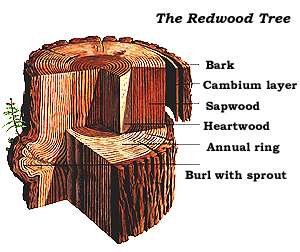Sequoia sempervirens
Sequoia sempervirens, commonly known as the coast redwood, is a species of evergreen tree in the cypress family Cupressaceae native to the coast of California and the southwestern corner of Oregon in the United States. It is known for being the tallest tree species in the world, with some specimens reaching heights of over 379 feet (115.5 meters). The coast redwood thrives in the moist, foggy climate of the Pacific Coast, where it forms dense, ancient forests, some of which are preserved in Redwood National and State Parks.
Description[edit | edit source]
The Sequoia sempervirens is an evergreen tree, capable of reaching up to 379 feet in height and 29 feet in diameter at breast height. The bark of the coast redwood is very thick, up to 12 inches, and fibrous, providing significant protection against fire. The leaves are arranged in a spiral pattern, are needle-like, and vary in length from 15 to 25 millimeters. The tree's cones are small, 15–32 millimeters long, and contain 14–24 seeds. The coast redwood is known for its longevity, with some specimens being over 2,200 years old.
Habitat and Ecology[edit | edit source]
Sequoia sempervirens prefers the moist, humid climate along the Pacific coast, thriving in the fog that is common in this region. The fog provides a critical source of moisture during the dry summer months, contributing to the tree's growth and survival. The species is found in a narrow strip along the coast, from southwestern Oregon down through California, reaching as far south as the Big Sur area. The trees are an integral part of the coastal ecosystem, providing habitat for numerous species of plants, animals, and fungi.
Conservation[edit | edit source]
The coast redwood has faced significant threats from logging and land development, leading to a substantial reduction in its range and the size of its old-growth forests. Conservation efforts have led to the protection of significant areas of redwood forest, most notably in the Redwood National and State Parks and other state and national parks. These protected areas are crucial for the preservation of the species and its ecosystem. Ongoing conservation efforts focus on protecting existing forests, restoring logged areas, and studying the impacts of climate change on the species.
Cultural and Historical Significance[edit | edit source]
The coast redwood has held significant cultural and spiritual significance for the indigenous peoples of the region, who have used the tree's wood for building, tools, and ceremonial purposes. In the 19th and early 20th centuries, the redwood forests were heavily logged, leading to a significant loss of old-growth forests. Today, the coast redwood is celebrated for its beauty, ecological importance, and as a symbol of conservation efforts.
See Also[edit | edit source]
Search WikiMD
Ad.Tired of being Overweight? Try W8MD's physician weight loss program.
Semaglutide (Ozempic / Wegovy and Tirzepatide (Mounjaro / Zepbound) available.
Advertise on WikiMD
|
WikiMD's Wellness Encyclopedia |
| Let Food Be Thy Medicine Medicine Thy Food - Hippocrates |
Translate this page: - East Asian
中文,
日本,
한국어,
South Asian
हिन्दी,
தமிழ்,
తెలుగు,
Urdu,
ಕನ್ನಡ,
Southeast Asian
Indonesian,
Vietnamese,
Thai,
မြန်မာဘာသာ,
বাংলা
European
español,
Deutsch,
français,
Greek,
português do Brasil,
polski,
română,
русский,
Nederlands,
norsk,
svenska,
suomi,
Italian
Middle Eastern & African
عربى,
Turkish,
Persian,
Hebrew,
Afrikaans,
isiZulu,
Kiswahili,
Other
Bulgarian,
Hungarian,
Czech,
Swedish,
മലയാളം,
मराठी,
ਪੰਜਾਬੀ,
ગુજરાતી,
Portuguese,
Ukrainian
Medical Disclaimer: WikiMD is not a substitute for professional medical advice. The information on WikiMD is provided as an information resource only, may be incorrect, outdated or misleading, and is not to be used or relied on for any diagnostic or treatment purposes. Please consult your health care provider before making any healthcare decisions or for guidance about a specific medical condition. WikiMD expressly disclaims responsibility, and shall have no liability, for any damages, loss, injury, or liability whatsoever suffered as a result of your reliance on the information contained in this site. By visiting this site you agree to the foregoing terms and conditions, which may from time to time be changed or supplemented by WikiMD. If you do not agree to the foregoing terms and conditions, you should not enter or use this site. See full disclaimer.
Credits:Most images are courtesy of Wikimedia commons, and templates, categories Wikipedia, licensed under CC BY SA or similar.
Contributors: Prab R. Tumpati, MD






